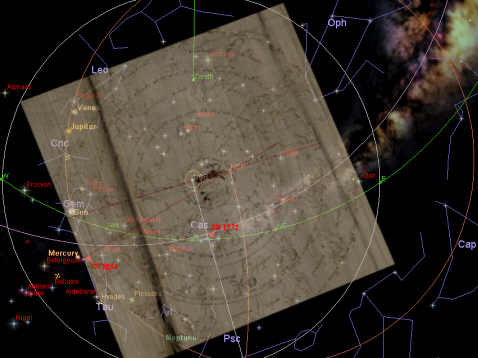|
|
| f71v, Cancer. Voynich Manuscript. Credit: Beinecke Rare Book and Manuscript Library, Yale University. |
f71v, 4. ZODIAC FOLIOS: CANCER
|
|
| f71v, Cancer. Voynich Manuscript. Credit: Beinecke Rare Book and Manuscript Library, Yale University. |
This folio is allocated to the month of June and the events for this month are shown below:
| June |
2nd 12th 16th 18th 20th 24th 30th |
Mercury at inferior conjunction Earth at Aphelion Summer Solstice Saturn at quadrature Occultation of Hyades by the Moon Mercury greatest elongation west. Mars at conjunction |
|
|
| f71v, Cancer. Voynich Manuscript. Credit: Beinecke Rare Book and Manuscript Library, Yale University. Overlay by P. Han showing main folio markers. |
The Cancer folio should have a lot
going on as there are a number of major astronomical events and it is a folio
where a nymph representing the earth may make a rare appearance. The main event is no doubt the Summer Solstice which may be indicated
by the crowned nymph, this appears very much darker than most of the ink as it
is a later addition but it may just have been making clearer a crown that was
already present. Mars and Mercury feature in this month and there are plenty of
male nymphs including one I absolutely designate a planet by its displaying retrograde
motion. Plenty of conjunctions occur and a
“Conjunction Nymph" is present. Two stars are missing which may describe a planet
or star being invisible in the Sun’s light at conjunction, one may be Mercury in
female form but the other is not likely to be Mars and may be the Hyades. The
nymph with no star at 3 O'clock looks female but only due to the darker ink so
may have been drawn originally as a male and be Mars, the nymph with no star at
7 O'clock is female and may represent the Hyades or Mercury. The
figures with brimmed hats running around the top of the outer circle of nymphs
may refer to Saturn at quadrature. Below is the folio marked with
suggested points of interest.
|
|
| f71v, Cancer. Voynich Manuscript. Credit: Beinecke Rare Book and Manuscript Library, Yale University. Overlay by P. Han showing main points of interest on the folio. |
As the main folio markers the crowned nymph suspected to represent the Summer Solstice and the markers may too relate to the sky at this time. The Summer Solstice is observed at the time of the rising sun and when the markers are overlaid onto a horizon based map of this event, the markers appear to indicate the Sun and SN 1054 in relation to the North Pole but also running through the ecliptic North Pole. On the North Pole centred Chinese style star map (without true sky colour to show more detail of sky) the fit is not quite as good and fits more comfortably if the intersection of the marker lines is centred on the Ecliptic North Pole, these specific circumstances may be because it is a solar event and one primarily observed from the horizon.
|
|
 |
| Horizon view star map (true sky colour), 16/06/1054 at sunrise, Kaifeng, China. Credit: Redshift6. f71v, Cancer. Voynich Manuscript Credit: Beinecke Rare Book and Manuscript Library, Yale University Overlay by P. Han showing main folio markers in relation to the Sun and SN 1054. |
Celestial North Pole centred star map, 16/06/1054 at sunrise, Kaifeng, China. Credit: Redshift6. f71v, Cancer. Voynich Manuscript. Credit: Beinecke Rare Book and Manuscript Library, Yale University Overlay by P. Han showing main folio markers in relation to the Sun and SN 1054. |
The Cancer folio is the only one to display three full circles of nymphs, possibly indicating the height of Summer and the longest period of daylight at the Summer Solstice, or it may reflect a major solar event. In the same way December (Capricorn) may exhibit only one circle of nymphs reflecting the depths of winter and the shortest period of daylight at the Winter Solstice, or else three to reflect a major solar event.
Copyright © 2010 P. Han